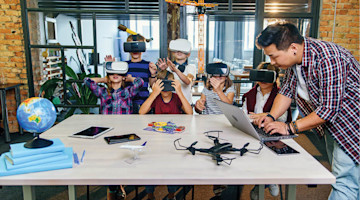As experienced, technically skilled workers continue to retire from the manufacturing workforce, the loss of tribal knowledge affects productivity, quality, and safety. Manufacturing companies are developing and deploying a variety of new technology-based systems and solutions to help them meet the challenges of this brain drain. We’ll take a look at a few technologies emerging in this important area.
Augmented reality
Augmented reality (AR) is one technology that is increasingly being used to provide knowledge transfer and training. AR can display information, data, procedures, and images in real time through smartphones, tablets, or smart glasses and can guide a technician remotely through learning a new process.
Learning modules that are available on demand with short training units have been shown to be a highly effective way to bring new employees up to speed on job responsibilities. Research has demonstrated that guiding someone through a task and showing them how to do it visually or experientially has a greater impact on learning than traditional classroom learning.
“Augmented reality offers the promise of providing the industrial workforce with relevant, contextual, and customized information and guidance from across the enterprise into their field of view in a seamless, hands-free, intuitive manner that transforms the way they work,” said Amar Dhaliwal, CEO, Atheer Inc.
An additional benefit of some AR platforms such as the Atheer platform is that it was developed to be a low-code platform, which is in effect “a no-code platform so that people with no programming experience whatsoever can create step-by-step guides on operating procedures, processes, and workflows. This has proven very successful,” said Dhaliwal.
AR also has important safety-related applications. Manufacturing production lines are often extremely complex, and a piece of equipment can require dozens of maintenance procedures that involve hundreds of components and many different steps. Inexperienced and untrained workers pose safety challenges to themselves and others if not completely trained on using equipment or handling materials properly.
CNC programming made easier
Sandvik recently developed and launched an AI-based application that enables the programming of simple components using 3D visualizations. Called Prism, and running on a tablet, it is user friendly and intuitive and does not require programming skills.
“Prism allows companies to recruit less experienced people and close a skills gap, and it was developed for precisely this challenge. With Prism, the user chooses the equipment and the features, and the application makes recommendations. Once those recommendations are accepted, it automatically generates what is called ‘g-code’ – the programming language that is exported to the machine to run the process. Prism can cut CNC coding times from hours to less than ten minutes,” said Johan Israelsson, senior vice president and head of global sales, Sandvik Applied Manufacturing Technologies.
Troubleshooting service problems
ABB has developed a service management application to enable service engineers to access knowledge and best practices when servicing ABB automation equipment and ABB-automated processes. Its ServicePro Service Management System is equipped with libraries of ABB equipment and associated factory- and field-developed preventive routines. Available on mobile devices and focused on safety, the software allows the user to identify, classify, and prioritize issues for immediate problem-solving. “This means an operator doesn’t need long years of experience or training to be able to troubleshoot common equipment or process issues,” said Dave Biros, ABB’s global product marketing manager for process automation.
The foundation of ABB ServicePro is a comprehensive knowledge database containing libraries of best practices. These procedures are documented, collected, integrated, and deployed through ServicePro and available to anyone who needs them at every facility that uses ServicePro. To date, ABB has developed modules for maintenance management, parts management, contract management, optimization management, and report management.
Conclusion
Generation Z and most millennials are digital natives and they are not only used to – they expect – technology in the workplace. They will not resist automation and will prefer it to repetitive tasks.








